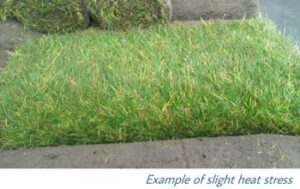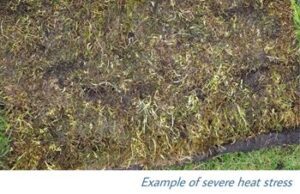Sod heating is a term used when harvested turf is suffering from heat stress due to being rolled up for too long and therefore hasn’t received any sunlight, fresh air or water; an early sign of this is when the turf looks yellow when unrolled.
Though turf may have looked perfectly green when it was harvested, sod heating can commonly occur as early as 24-48 hours after harvesting when the weather turns warmer, or if turf has been left for a period of time unrolled. Turf is a roll of living, breathing grass plants and therefore like any plants, leaving them without light and fresh air can cause them to deteriorate which generates heat; when turf is rolled up it effectively acts like a blanket, trapping the heat within the roll.
There is however, more to sod heating than just the grasses’ stress. Within every roll of turf there are micro-organisms which produce heat for the same reasons as the grass plants, as well as other organisms that continue to grow within the turf, which increase the temperature further. This is a natural process and something you may have noticed in compost bins or piles of grass clippings, where as they break down sometimes steam or a heat haze can be seen rising from them.
What can be done to avoid sod heating?
- Buy from a reputable company: experienced turf suppliers will harvest the turf when it is cool, for example at dawn in the summer months; indeed, some turf suppliers have invested heavily in technology to keep the turf cool right up to despatch.
- Prepare the ground you are laying the turf upon in advance, then there is more chance you can lay all of it on the day it is delivered.
- If the weather is particularly hot, wet the soil base before laying the turf.
- It’s very important to lay turf as soon as possible after delivery; it must be laid on the day of delivery in spring/summer or within 24 hours in the autumn/winter.
- If you don’t have time to lay the turf that day, unroll all of it on a flat surface and water gently; you can then lay the turf the following day.
- Thoroughly watering after laying will help the turf to cool and bed in.
- Never water turf when it is still rolled up or stacked.
- Don’t cover turf with anything such as a plastic sheet or tarpaulin; turf needs to breathe.
My delivery has just arrived and the turf is yellow
 If turf has yellowed, then it may have been affected by heat. The good news is that grass plants are pretty resilient and in most cases it’s fine to go ahead and lay the turf. Once the turf has been laid on to fertile soil and given a little TLC for a week or two – such as regular watering and staying off the grass until it recovers – it is very likely that it will transform into a lush green lawn.
If turf has yellowed, then it may have been affected by heat. The good news is that grass plants are pretty resilient and in most cases it’s fine to go ahead and lay the turf. Once the turf has been laid on to fertile soil and given a little TLC for a week or two – such as regular watering and staying off the grass until it recovers – it is very likely that it will transform into a lush green lawn.
If you find there has been no improvement after a week or so, take some photographs and contact your supplier for further advice.
What if the turf has a funny smell and is black?
 As the turf grass is delivered rolled up, firstly make sure the darker colour isn’t just from being in contact with the soil. If you find that the discolouration is just soil, this will clear during watering.
As the turf grass is delivered rolled up, firstly make sure the darker colour isn’t just from being in contact with the soil. If you find that the discolouration is just soil, this will clear during watering.
If the grass plants themselves are black or grey and have a smell, then this is potentially a more advanced result of heat stress. All is not lost however, as if there are only a few small patches or lines of black and the majority of the turf is green or yellow, then don’t delay laying it, because if only a small section is affected, overseeding will fill in the patches once the grass has died and dried out. If, like the image shown, the whole turf roll is affected, it will need to be replaced.
If you discover that the majority of your delivery has suffered severe heat stress, the best course of action is to take photographs of the turf as soon as it has been delivered and contact your supplier. Make sure to check the whole pallet of turf as sometimes it can just be a few rolls that have been affected.
Why is turf delivered in rolls if it causes sod heating?
Rolling turf has been found to be the most effective way of minimising damage during delivery. Delivering turf in rolls also makes the project of laying the lawn easier than delivering in slabs, which are sometimes heavy or awkward to handle, can still experience the same sod heating issues as rolls, and allow more edges of the sod to be exposed on the pallet during transportation.
What is the long-term damage of sod heating?
Once the turf has recovered from sod heating it has no future implications for the health of a lawn. With the correct maintenance, a newly laid turf will flourish.
We hope you have found this article interesting. If so, please feel free to share on Facebook, Twitter and Pinterest. If you would like to stay up-to date with our news, advice and special offers, why not sign up to our newsletter.